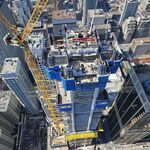typezed
Active Member
If it wasn't for Toronto's five months of winter we'd have golf courses and tennis courts and baseball diamonds and marinas and parks with picnic tables in them, just like other cities do. Damn our harsh winters.
I was enjoying your posting till I got to the third paragraph. So I drive regularly, walk reguarly, use GO and TTC ocassionally and take the odd cab here and there.....but my opinion is not valid because I don't cycle? Hogwash....or are to dismiss every opinion on this board where the person says (paraphrase) "I get around ok and I don't own a car, everyone should use transit and walk like I do".
I am one of those folks who would definitely bike more if there were safer places to do so.


What??? Are you serious? Winter 2009/10 may have had record low snowfall, but winter 2007/08 and 2008/09 both had plenty of snow ... and more importantly snow that persisted for weeks, because it never got above freezing.It never snows here. Period.
In November -- 1997. I remember playing in my touch football league the day after a major snowstorm. Had the game of my life as I recall.For the ones saying Toronto has 5 months of snow, that's complete BS. When have you seen snow in November or April? I can't remember seeing it.
In November -- 1997. I remember playing in my touch football league the day after a major snowstorm. Had the game of my life as I recall.
Why are all the bicycle racks at the subway stations (ie. Bathurst Station) filled with bicycles, even during winter? Why do I see people on bicycles during snowstorms? Why do I see bicycles while its raining? If you look, you will actually see bicycles out in all kinds of weather and time of day or night. They are there. Because they take up so little space, they are a benefit to the roadspace, unlike the 2 tons of metal and rubber that wreck roads and take up valuable real estate for most of the day.
There are some big obstacles to biking that are almost never discussed that I find even more annoying than the lack of bicycle lanes on major streets.
The first is the proliferation of minor one-way streets that are meant to reduce car traffic on side streets. These are particularly bad in the Annex and Grange Park; you basically have to disobey the road rules as a bicyclist if you don't want to circle around these streets. Slowly but surely, the city is introducing contra-flow bike lanes to some of these streets, but for the most part, bicyclists just cheat and travel against traffic.
Did you get those numbers from the spacing article? Canada Weather Office gives Toronto temperatures as follows:
Dec: -3.7/+1.8
Jan: -7.3/-1.1
Feb: -6.3/-0.2
Mar: -2/+4.6
Until recently, I wouldn't even try biking in winter, but since I've been doing it, I realize it can be more pleasant than sitting in a cold car, as the body creates heat naturally with exercise. And biking in snow is nicer than biking in rain, you don't really get wet.
My first question is, why are they at bathurst station vs locked up somewhere on Univeristy? when you say filled, 40 bikes?
How many cars go through a lane of univeristy on any given day? thousands?! - further more, the demographic that live near bathurst (annex) is very different than drivers that come down univerisyt from avenue.
It's this whole implementation of ideology vs analyzing the data.
Again, I think bike lanes are good in certain areas but building bike lanes for the sake of bike lanes are a bad idea. People should look at the costs of implementing them.
College/ harbour are great bike lanes, it services the an important corridor for U of T and a large biking crowd, it doesn't take away traffic flow or cause excess congestion.
Univeristy is very different, it sounds like a great 'idea' , but how does it service the biking demographic? Their begining point vs their destination? People that lvie in yorkvile that need to go to Bay Street to work? (you think those are the drivers on univeristy?)
Mcaul is a better alternative, and it won't cause the congestion that it would on Univeristy.
How many of the drivers coming down avenue rd do you think will get on a bike, and more importantly, how many drivers do you need to get off the road to offset the pollution caused by the excess congestion?
the star has long supported expansion of bike lanes around the city. Cycling is not only a pollution-free way to commute, it is also good exercise. If more people are persuaded to leave their cars at home and ride their bikes to work, everyone wins. But the proposal to put bike lanes on university ave. Makes no sense.
The proposal, to be considered by city council’s works committee on tuesday, is for a pilot project narrowing the eight lanes of university ave. To six, with bike lanes taking up the remaining space. The pilot is to run from early july until the end of september.
The stated goal is to provide a safer environment for cyclists, but the real intent appears to be to make it more difficult for people to drive into town.
“traffic capacity analysis indicates that university ave. Could operate with three travel lanes in each direction in the peak periods with little impact (our emphasis) on the current levels of service,” states a staff report to the works committee. But anyone driving up or down university knows the traffic is already heavy, even with eight lanes. Take two lanes out and it stands to reason that congestion will be 25 per cent worse. It won’t get people out of their cars; it will simply keep them in longer, spewing more exhaust into the atmosphere.
Nor should university ave. Be viewed in isolation. Council has already approved closing off a lane on heavily travelled jarvis st. – another major north-south route – to accommodate bicycles.
At city hall, the chief advocate of bike lanes is councillor glenn de baeremaeker, chair of the works committee and himself an avid cyclist. (he bikes into work at city hall every day from his home at eglinton ave. And mccowan rd., a trip that takes him 70 minutes.) de baeremaeker says it is in the best interest of motorists to add bike lanes to routes like university ave. Because that will mean fewer cars on the road for the remaining drivers. But he acknowledges that the number of people who choose to cycle to work will always be relatively small, and even smaller in bad weather. “ninety per cent of the cyclists disappear in the winter,” he says.
People drive to work for a variety of reasons, not all of them selfish. Some need their cars at work; others do not have easy access to rapid transit (given our stunted subway network). Plus, downtown is more than a workplace; it is also a major entertainment district, and people often drive to the theatre or sports events or restaurants.
As for university ave., it is a major route not only for cars but also for buses and ambulances.
There is no need for a bike lane pilot project on university ave. It is self-evidently a bad idea, and should be turned down by the works committee on tuesday. There are places for bike lanes in the city, but university ave. Isn’t one of them.
The question that was posed was have you ever seen snow in November, and the poster said that they never had. GenerationW was merely answering the question. You can't then use that against him.And in January 1999 we called in the army to clear the snow.....what does picking one month at a time prove here?




